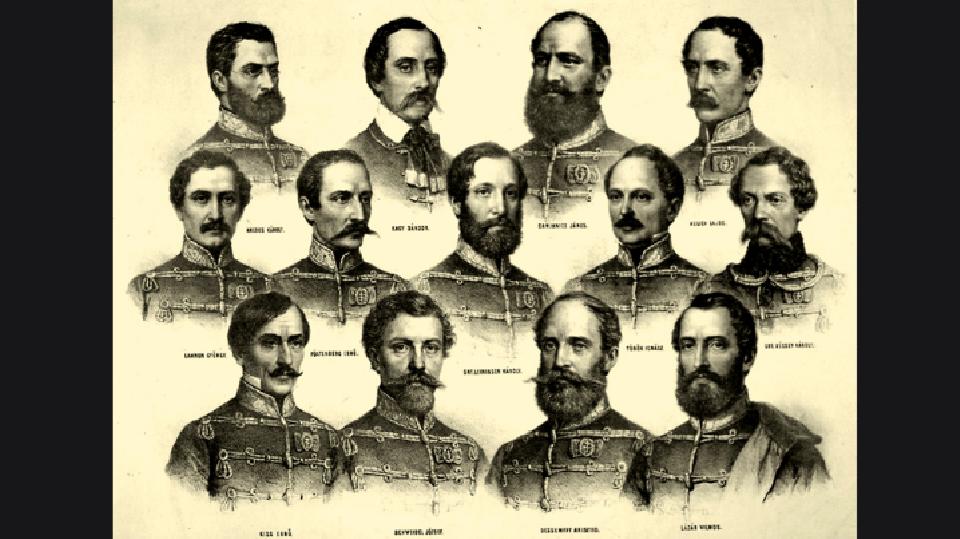One hundred and seventy-two years ago, on October 6, 1849, the thirteen generals of the Hungarian National Guard were executed in Arad, and Count Lajos Batthyány, the prime minister of the first responsible Hungarian government, was executed in Pest.
The defeat of the 1848-1849 war of independence was followed by cruel reprisals. The common soldiers received an amnesty, but many of them were conscripted into the imperial army, and the higher-ranking officers and officials were court-martialed.
The order of the trials was determined by the degree of "guilt": first, the trial of the "main culprits", Lajos Batthyány in Olmütz (Olomouc) in the Czech Republic, and the chief officers commanding the independent corps of the Home Army in Arad, were held
.
Batthyány, who resigned from his position on October 2, 1848, was arrested in Pest in January 1849. On August 30, 1849, the politician imprisoned in Olmütz at the time of the fall of the War of Independence was sentenced by the military court to death by rope and complete confiscation of his property on orders from a higher authority, but he was recommended for pardon.
The trial even violated the Viennese directive that the defendants could only be held responsible for revolutionary acts after the dissolution of the Hungarian parliament on October 3, 1848, because the basis of the charge was Batthyány's previous acts (among other things, contact with foreign powers, the Croats and Austria failure to reach an agreement with the government, recruitment for the National Guard without royal approval and paper money issuance) were formed. The recommendation for clemency had to be taken into account in Austria according to the unwritten rule, so Batthyány was taken to Pest, where General Haynau, who ruled Hungary with full power, confirmed the sentence on October 5, 1849.
In Arad, on September 26, 1849, thirteen generals and one colonel (Vilmos Lázár, who also commanded an independent army corps) were sentenced to death for insulting majesty and rebellion. Haynau approved this on September 30, but the sentence of András Gáspár (József Ferenc's former riding master) was changed to prison at the last moment.
The executions were timed for October 6, the anniversary of the Vienna uprising and the lynching of Austrian Minister of War Latour a year earlier. Batthyány stabbed himself in the neck with a smuggled dagger at night in the Újépélet in Pest, which served as a prison, and due to his severe blood loss, it was not possible to carry out the dishonorable hanging, which is usually used for law enforcement officers.
Since the execution had to take place, the local commander changed the death penalty by rope to "powder and bullets" under his own authority - after hearing this, Haynau later had a nervous breakdown. Batthyány did not allow himself to be blindfolded and directed the firing squad himself, his last words were spoken in three languages: "Allez, Jäger! (On it, hunters!) Long live the homeland!” On October 6, 1926, at the scene of his execution, at the wall of the former Újépéulet, the Batthyány Memorial Church, designed by Móric Pogány, was inaugurated. It is a symbol of freedom and became a regular scene of opposition demonstrations on March 15 in the last years of Kádárism. The ashes of Hungary's first prime minister rest in the Batthyány Mausoleum in the National Cemetery on Fiumei Street.
Also in Arad, the thirteen chief officers of the army were executed on October 6: Lajos Aulich, János Damjanich, Aristzid Dessewffy, Ernő Kiss, Károly Knézich, György Láhner (Lahner), Vilmos Lázár, Károly Leiningen-Westerburg, József Nagysándor, Ernőt Poeltenberg, József Schweidel , Ignat Török and Károly Vécsey. Kiss, Schweidel, Dessewffy and Lázár, who were "pardoned" to death by bullet, were shot dead in the northern rampart of the castle at dawn, the other convicts were then hanged on gallows hastily assembled south of the castle.
The corpses were left on the gallows until evening as a deterrent, but they achieved the exact opposite effect, because the place of execution became a real place of farewell procession. Today, there is a memorial column on the former place of loss, the memory of the martyrs is preserved in the city by the Statue of Liberty, restored in 2004, the work of György Zala.
Three more army officers were executed in Arad until February 1850, army colonel Norbert Ormai, army colonel Lajos Kazinczy (son of Ferenc Kazinczy) and lieutenant colonel Ludwig Hauk, aide-de-camp to General Bem. National Guard Major General János Lenkey did not go before the firing squad because he was insane, he died in the castle prison in February 1850.
During the post-war reprisals, approximately 500 death sentences were handed down and around 110 executed. The emigrants were executed in effigy - in their absence - that is, their names were nailed to the gallows. The wave of revenge only subsided in July 1850, when, due to general European indignation, the Viennese court retired Haynaut, who had "exceeded his authority".
On November 24, 2001, the government declared October 6 a national day of mourning. On this day, the state flag is lowered to half-mast, the mourning flag is hoisted on public buildings, and commemorations are held in schools.
Source: MTI













